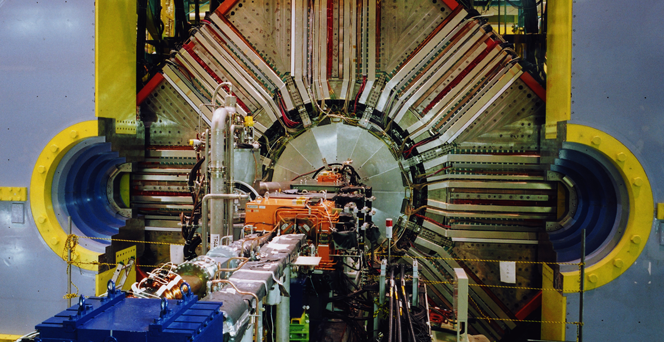URL: https://www.desy.de/e141261/e158573/e160650/index_eng.html
Breadcrumb Navigation

Belle II
Particle physics experiment Belle II
In the big bang, matter and antimatter should have been created in equal amounts. But why is the universe today filled almost only with matter? The Belle II experiment at the SuperKEKB accelerator in Japan aims to help solve this great mystery of particle physics. DESY too is involved in the ambitious experiment.
Physicists attribute the different behaviour of matter and antimatter to the violation of the so-called CP symmetry, which states that the laws of physics should not change if a particle is interchanged with its antiparticle and the signs of all spatial coordinates are flipped. Scientists have already identified processes that break this CP symmetry. However, the extent of the observed CP violation is not sufficient to explain the actual excess of matter in the universe. This excess could be brought about by “new physics” that goes beyond the Standard Model of particle physics.
There are many ideas and theories about what this new physics could be – ranging from extra dimensions to supersymmetry. One way to find out which of those theories correctly describes reality is to measure the difference in behaviour of matter and antimatter extremely accurately. To this end, the Japanese accelerator laboratory KEK in Tsukuba upgraded its KEKB ring accelerator, which it operated from 1999 to 2010, to a “super B factory” – an electron–positron collider that produces a large amount of particles called B mesons. The bases for these B factories were established, among others, at the DORIS storage ring at DESY, where researchers observed the conversion of a B meson into its antiparticle, an anti-B meson, for the first time in 1987 using the ARGUS detector.
Particle production at the B factory
The three-kilometre-long upgraded accelerator SuperKEKB will ultimately deliver a 30-fold higher collision rate than its predecessor and thus produce about 700 pairs of B mesons per second. Their decays are measured with high precision using the Belle II detector. Together with seven German universities, the Max Planck Institute for Physics and the Max Planck Semiconductor Laboratory in Munich, which have formed a research focus funded by the German research ministry since 2020, DESY has built a central component of the large device, the pixel vertex detector, which records the particle decays right at the collision point. In this detector, the novel DEPFET technology developed in Munich, which delivers up to 50 000 high-resolution images per second, is being used for the first time. In addition, DESY participates in the data acquisition and analysis of Belle II. As part of its Interdisciplinary Data and Analysis Facility (IDAF), DESY provides its Grid infrastructure and computer resources for this purpose.
The Belle II collaboration consists of more than 1000 scientists from 28 countries, with German physicists constituting the largest group. SuperKEKB accelerated its first particles in 2016, and the research programme with the Belle II detector started in 2018. The record collision rate at SuperKEKB allows unique experiments that are complementary to those at the LHC at CERN in Geneva, where B mesons are examined using the LHCb detector.
Long-time collaboration
Collaboration with Japanese particle physics institutes has a long tradition at DESY. In the early 1970s already, Japanese scientists participated in the DASP experiment at DESY’s storage ring DORIS, followed by the JADE (“JApan–Deutschland–England”) experiment at the PETRA accelerator. The HERA accelerator saw major Japanese participation in the ZEUS and HERMES experiments. DESY is also cooperating with Japanese institutions within the framework of future projects, such as detector development for a future collider. With DESY’s participation in Belle II, these joint research activities were extended for the first time to an experiment in Japan.
Belle II
- Experiment for measuring electron–positron collisions at the SuperKEKB accelerator of the KEK research centre in Tsukuba, Japan
- 7.5 m long, 7 m high
- Start of research operation: 2018
- Expected number of generated B meson pairs: ca. 40 billion
Belle
- Predecessor experiment of Belle II at the KEKB accelerator
- Operation: from 1999 to 2010
- Number of generated B meson pairs: nearly 800 million
- Data analysis: ongoing


